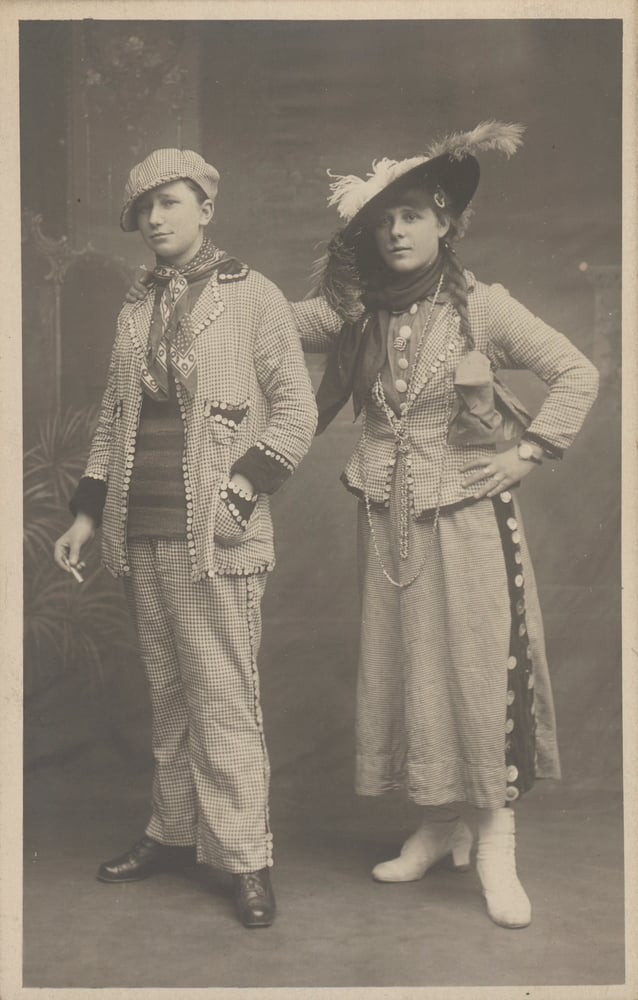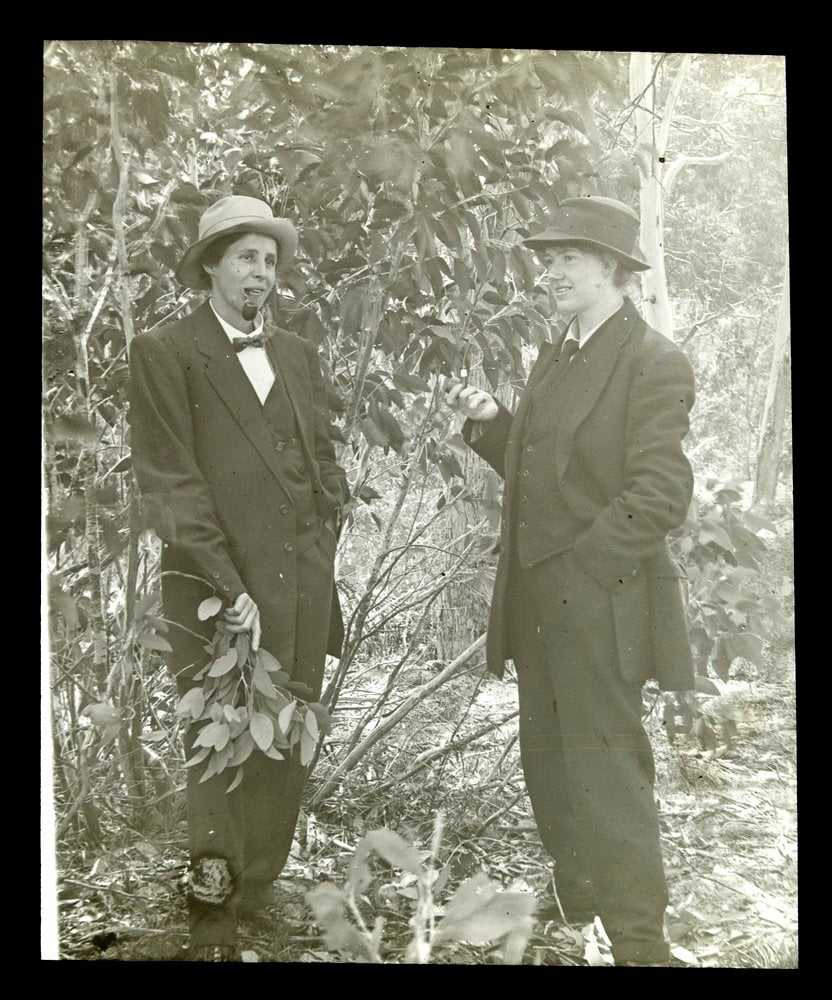This is where it starts, in the pictures archive, where visual records are kept. You discover photographic images dislodged from the past. They draw you in, attracting you to the odd or unusual.
Accompanying the images are written descriptions with misplaced pronouns and sometimes unstable definitions of gender. You have questions: is there something else to be seen here? Something … every now and again discernible, something queer?
Women cross-dressing – whether parodying the conventional gender roles of the late 19th and early 20th centuries, performing tomboy characters on stage, or dressing up (and down) to earn a living – might catch your eye.
There is pleasure in detecting nuances of dress that insinuate a disruptive sexuality. Or at the very least seeing women adopting male personas for the camera, as a means of visual resistance and social play, reflecting the cultural tensions of the day.1
Take a stroll down trouser lane

Three men (or women dressed as men) standing in paddock, wearing suits, Walter Hodgkinson, glass negative, c. 1880-1900, Pictures Collection, State Library Victoria, H42506/47
So are they men or women? They are indeed women! Note the lack of facial hair, hats sitting high on the head (hair tucked in behind or in buns) and feminine footwear.
Many photographs from the late 19th century depict women wearing men’s clothes and flaunting the signifiers of masculinity: a pipe, the smoking of a cigarette, a ‘lad’s’ stance with hands in pockets or one’s vest, men’s hats askew, the addition of a fob watch and neckties all round.
These three women are playing up to the camera, dressed in men’s garb and behaving mannishly long before pants became socially suitable clothing for women. Dressing up and being photographed in the backyard suggests a spontaneity and joie de vire, whilst casting shadows of masculinity provides an apt backdrop for the posing chaps.
Acted out in the private sphere of female friendship, performance of masculinity for the camera was an acceptable form of social entertainment in the 19th century. Gender masquerade in these photographs could, in such a context, be seen as embodying an emerging queer visibility.2
Talking the talk and walking the walk: male impersonators on the stage

Tittell Brune, Talma & Co., photographers, albumen silver Paris panel, c. 1905, Pictures Collection, State Library Victoria, H9127
This studio portrait shows Minnie Tittell Brune as the Duke of Richmond, in Edmond Rostand’s play L’Aiglon. She makes a dashing figure in her knee-high boots, breeches and long-waisted coat.
The audience at the time knew the Duke was a deception, and that was exactly the point. One can only surmise the desires of her audience, which might include: wanting to be the cross-dressed woman, being desired by the cross-dressed woman, and/or desiring the cross-dressed woman.3
The theatre was one profession in which women earned equal wages to men for comparable work. As a consequence of the cross-dressing male, the female actor was also able to display qualities not associated with respectable Edwardian women. Brune is credited as being the inspiration for the ‘gallery girls craze’, the early incarnation of the fan club that was made up of young adoring female audience members.4
Girls will be boys

Couple dressed as Pearly Costers, Green Brothers, photographic print, c. 1913-26 Pictures Collection, State Library Victoria, H2014.89/23
This is a photograph of either two Pearly Coster music hall performers (a King and Queen?) on tour posing for a publicity shot, or a young couple in fancy dress marking the occasion with a studio portrait.5 This is a Kodak ‘real photo postcard’ and was intended for both private and public circulation.
However, you do wonder … about the androgynous figure on the left, directly returning their gaze to the camera. And what of their dress: trousers and men’s shoes and the kerchief resting on the chest (a form of concealment?), one hand in the pocket, the other casually holding a cigarette, and their hair tucked up into cap?
There’s no doubt, however that the one on the right is a young woman, her stance both relaxed and assertive with one hand on her hip and the other firmly planted on her partner’s shoulder.
The contemporary lesbian-like pose is further suggested by the accompanying archive description: ‘possibly both girls … and jacket in same checked material as the other’s suit, right hand on ‘boys’ shoulder’.
Behind the lens

Two women in bush, dressed in men’s suits, one with pipe in her mouth, Mt. Buffalo, Vic., Alice Manfield, glass lantern slide, c. 1890-c. 1930, Pictures Collection, State Library Victoria, H2003.95/114
The photographer here is well known entity Guide Alice (Alice Manfield), a Mt Buffalo tourist guide in the early 1900s, who, out of practicality, designed and wore a ‘trouser suit’. This caused quite a stir at the time and it was reported that some women thought she had ‘cheapened and spoilt herself by dressing in “masculine attire” ‘.6 Alice, a naturalist and keen photographer, shot this photograph, which would account for the bush scene backdrop, and possibly the subject of two ladies who had no issues with wearing pants.
Camera as witness

Alice Veale and Ethel dressed in men’s clothing, Lake Bolac, Vic., W. E Veale, glass lantern slide, c. 1890 – c. 1900, Pictures Collection, State Library Victoria, H2002.18/68
There has been a long-standing tradition of women adopting male attire for work, adventure and sexuality. These women, often referred to as ‘passing women’, experienced greater freedom of movement and sought access to higher pay, manual labour, the vote, education and same-sex relationships.
Photographs of cross dressing, like those seen here, allowed individuals to document their lives outside of traditional social roles. Whether they seem more playful than anxious reflects the performative nature of their identity either on, or off, the stage.
Viewing these photographs in the here and now, and conscious of retrospectively misreading the intention of historical images, we will let these cultural artefacts speak to us how they will.
Notes
- Catherine Smith and Cynthia Greig, Women in Pants, New York: Harry N. Abrams, 2003, p.16.
- Catherine Lord and Richard Meyer, Art & Queer Culture, New York: Phaidon Press, 2013, p.55.
- Sally Newman, ‘Sites of Desire: Reading the Lesbian Archive’, Australian Feminist Studies, vol. 25, no. 64, June 2010, p.155.
- H.B. Irving, ‘New Century Stage Favorites’, Age, 7 October 1933, p.6.
- Pearly Costers originated from 19th-century London street vendors who wore clothes decorated with pearl buttons.
- Edith Hoy, Historiette of the Manfields who Began their Mt. Buffalo Saga when the Buckland was at its Heyday in the early 50s,
- Harrietville, Vic.: Harrietville Historical Society, 1965.
This post is in the room brochure for the exhibition WE ARE HERE: contemporary artists exploring their queer cultural heritage, curated by Angela Bailey. It’s open at State Library Victoria from 19 January to 1 April 2018.


Dear Susan, it’s the Duke of Reichstadt, not of Richmond, for Napoleon’s son in Rostand’s “L’Aiglon”. Ironically, “baron de Richemont” was one of the false Louises XVII, impostors in the name of the son of Louis XVI and Marie-Antoinette, dead in 1795, who abounded mostly during the Bourbon Restoration period in France. Reichstadt is the old name of today’s Zakupy, a small town in the Czech Republic, and it was a duchy created for Napoleon’s son by his maternal grandfather, the emperor Francis I of Austria, when he decided that his grandson would never rise to any political prominence. The Duke never travelled there, as he had been kept in the golden cage of the imperial palaces in Vienna, where he died young. The role in Rostand’s play, as well as the opera by Honegger/Ibert (1937) is usually played by women, as it was written originally for Sarah Bernhardt. Some men played it, too, but to my present knowledge only in pre-revolutionary Russia, Poland and sometimes in France.
Kind regards 🙂
Pingback: A GLAMorous look at Midsumma 2020 | Queeries & Clareification
Thank you for the feedback – very interesting!